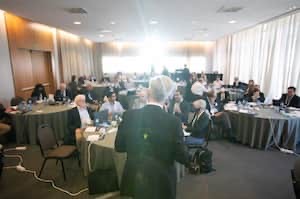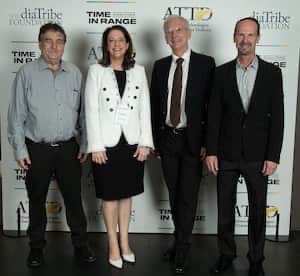Progress Made Towards the Global Adoption of Time in Range
By Matthew Garza
 In April 2022, 32 of the world’s premier diabetes experts gathered in Barcelona, along with representatives from industry, advocacy, and regulatory bodies, to discuss the use of continuous glucose monitors in clinical trials. The lively discussion is expected to have a great impact on propelling the use of Time in Range globally.
In April 2022, 32 of the world’s premier diabetes experts gathered in Barcelona, along with representatives from industry, advocacy, and regulatory bodies, to discuss the use of continuous glucose monitors in clinical trials. The lively discussion is expected to have a great impact on propelling the use of Time in Range globally.
On April 26, 2022, one day before the start of the ATTD 2022 conference in Barcelona, the diaTribe Time in Range Coalition gathered dozens of the world’s leading diabetes experts for an International Consensus Meeting on the Standardization of Continuous Glucose Monitors (CGM) in Clinical Trials.
This meeting came to fruition after tireless efforts over the past two years by the Time in Range Coalition. The coalition has been working to improve the awareness and adoption of Time in Range (TIR) globally as the primary glucose metric for daily management. During those years, the coalition compiled a review of the evidence on TIR – consisting of over 130 research studies. The studies highlighted the value of CGM metrics, the accuracy of these devices, patient-reported outcomes, CGM costs, glucose variability, and their use in clinical practice.
 “Time in Range can transform diabetes care by arming clinicians and regulatory bodies with the real-time health data that patients on CGM have been using for years now,” said Julie Heverly, senior director of the Time in Range Coalition, who presented an update on the consensus meeting at the final day of the conference.
“Time in Range can transform diabetes care by arming clinicians and regulatory bodies with the real-time health data that patients on CGM have been using for years now,” said Julie Heverly, senior director of the Time in Range Coalition, who presented an update on the consensus meeting at the final day of the conference.
This is an area where research is beginning to emerge to indicate the value of TIR, but there remain clear gaps in available research that must be addressed, such as understanding the use of TIR and CGM in people with type 2 diabetes, use of intermittent CGM, and how TIR affects a person’s quality of life and mental health.
Regardless of such gaps, diaTribe and the coalition had constructive meetings with the FDA in 2021 to discuss the adoption of TIR as a clinically meaningful metric and its use by regulatory bodies – such as inclusion in the drug labels of medication.
During these meetings, the FDA recognized the importance of TIR and CGM Metrics for patients but indicated that the lack of standardized collection, analysis and reporting across trials made it challenging for them to consider including in their approval processes.
.jpg) The consensus meeting at ATTD 2022 put on by diaTribe and ATTD was initiated to solve this precise problem. Experts, led by Professor Tadej Battelino, co-chair of ATTD and head of the Department of Endocrinology, Diabetes & Metabolism at University of Ljubljana, Slovenia, worked through a list of draft recommendations for the standardized use of CGM in clinical trials. Notable topics of discussion touched on whether blinded or unblinded CGM should be used in trials, the type of device used, the amount of data that needed to be collected, and the importance of device training and education for users and healthcare providers.
The consensus meeting at ATTD 2022 put on by diaTribe and ATTD was initiated to solve this precise problem. Experts, led by Professor Tadej Battelino, co-chair of ATTD and head of the Department of Endocrinology, Diabetes & Metabolism at University of Ljubljana, Slovenia, worked through a list of draft recommendations for the standardized use of CGM in clinical trials. Notable topics of discussion touched on whether blinded or unblinded CGM should be used in trials, the type of device used, the amount of data that needed to be collected, and the importance of device training and education for users and healthcare providers.
All of the discussed topics have far-reaching implications for people with diabetes. This consensus could change the way clinical trials are conducted, making CGM a consistent part of the collection of data when companies and researchers are studying drugs or therapies while seeking approval.
“[The group] made significant progress towards a consensus,” said Heverly, indicating that she was encouraged by the direction of the discussion and level of agreement at the working session.
Professor Moshe Phillip, director of the Institute for Endocrinology and Diabetes at the Schneider Children’s Medical Center of Israel, co-chair of ATTD and one of the experts at the consensus meeting, explained that the group will continue to work through the document and expects to have a final document later this year.
“We know that using TIR data can proactively prevent health complications and help people feel empowered in their diabetes management,” said Heverly.
The Time in Range Coalition hopes the consensus statement will further advance its efforts to increase the global awareness and adoption of TIR by establishing the TIR’s importance in a regulatory capacity.








